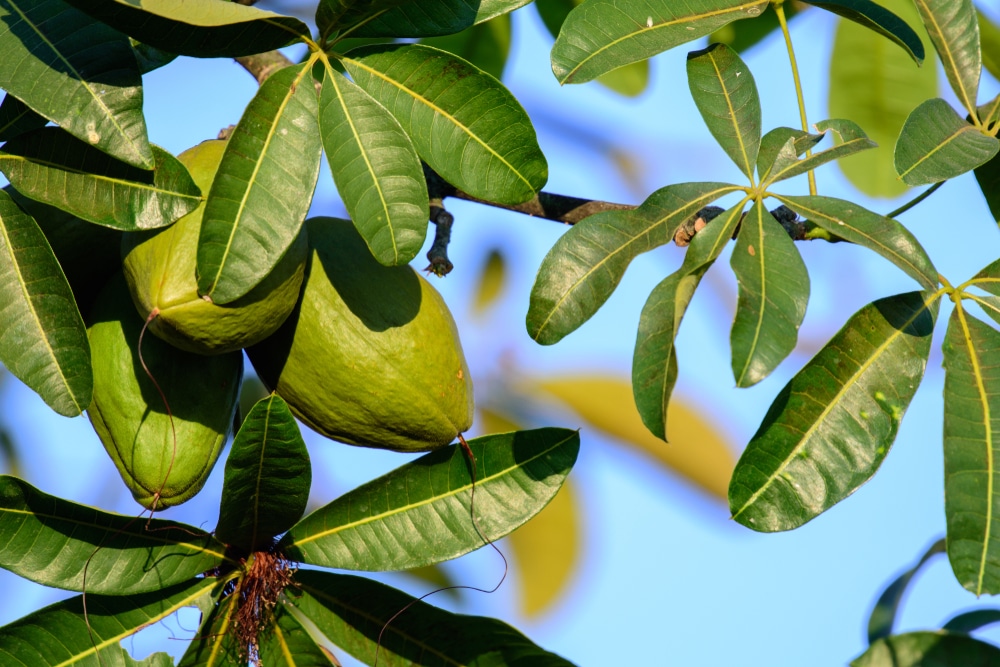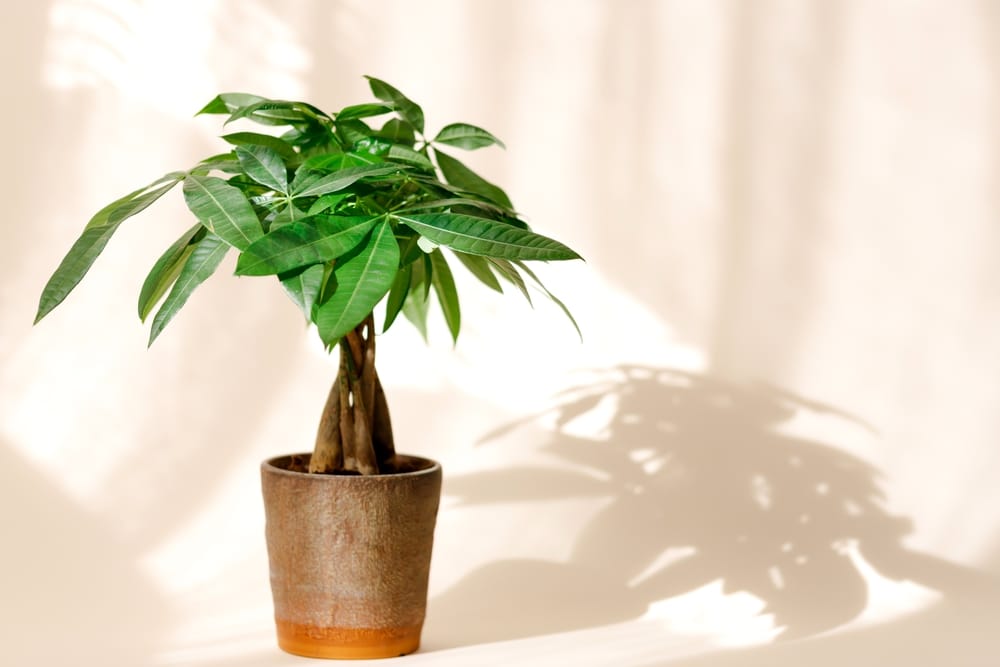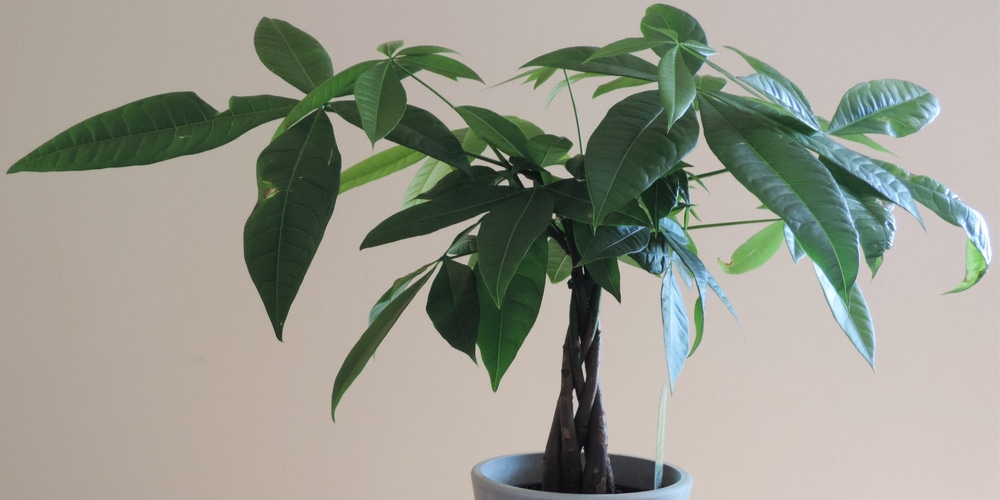Pachira aquatica, or the money tree, is a popular houseplant with striking umbrella-like leaves. A braided trunk frequently accompanies it. The money tree is native to Central and South America and grows in the moist ground beside rivers or on hillsides. Although it’s frequently grown as a houseplant, the money tree can reach up to 60 feet in its natural habitat.

| Botanical Name | Pachira aquatica |
| Common Name | Pachira nut, Money tree, Guiana chestnut, Money plant, Provision tree
Plant Type: Perennial |
| Plant Type | Perennial |
| Flower Color | Yellowish-white |
| Size When Mature | 36 to 72 inches indoor, 240 to 260 inches outdoor |
| Bloom Time | Every summer for trees planted outdoor; indoor plants will not bloom |
| Sun Requirements | Full sun, partial shade |
| USDA Hardiness Zones | 10 to 12 if kept outdoor; if kept indoor, the plant will thrive in all zones |
| Soil PH Range | 6.0–7.5 |
| Soil Type | Moist, well-drained |
| Water Needs | Moderate |
| Native Area | Central and South America |
What You Need to Know About Pachira Aquatica
Also known as the prosperity tree, the Pachira aquatica is an unusual-looking plant often kept as a houseplant or bonsai. Money trees are typically 36 to 72 inches, but they can grow up to 260 inches outdoors.
A money tree is said to bring good fortune, according to feng shui. It is thought that prosperity has been trapped within the trunk and that the five-lobed leaves are also blessed.
Money trees are frequently given as wedding or housewarming presents because of this. The coiled trunk isn’t a natural feature of the plant. Young money trees have a single straight trunk, often braided by growers to give it an appealing look.
Aside from being a lucky plant, the money tree also helps purify the air. It is one of the houseplants that help remove indoor air pollutants, such as formaldehyde and benzene.
As for its flowers, flowering is impossible for money trees kept indoors. However, if you have an outdoor money tree that blooms, the flowers will be small and yellowish-white. They are followed by brown fruits that contain seeds.
How to Care for Pachira Aquatica
Here’s everything you need to know about growing and caring for a thriving Shamrock Plant.
Light
Money trees can tolerate a wide range of light conditions but prefer bright, indirect light. If you are growing your money tree indoors, place it near a window where it will receive at least six hours of sunlight per day. You can also grow money trees under fluorescent lights.
Money trees kept outdoors will tolerate direct sunlight. However, too much direct sunlight can cause the leaves to scorch.
Water and Soil Needs
Water is required for the health of any plant, and money trees are no exception. They should be watered regularly, even if only the top inch of the earth is dry.
The watering frequency typically increases in the spring and summer when the weather is warmer, and the tree is actively growing. In the cooler months of fall and winter, the tree will require less water as it goes into a period of dormancy. If the tree is kept indoors, it may need to be watered more frequently than a tree that is outdoors, as indoor conditions tend to be drier.
Money trees are tolerant of a wide range of watering schedules, but following a regular schedule will help keep the tree healthy and prevent problems such as leaf drop.
Well-draining soil is essential for money trees. If the soil is too dense, it won’t allow water to circulate properly, and the roots will suffocate. On the other hand, if the soil drains too quickly, the roots will dry out.
The ideal soil mixture for a money tree is rich in nutrients and allows water to drain quickly. If your soil doesn’t meet these requirements, you can amend it with sand or gravel. Just be sure to avoid using any chemicals, as they can damage the roots of your money tree.
Temperature Requirements
While money trees can tolerate a wide range of temperatures, they prefer warm weather and will not do well in temperatures that drop below 50 degrees Fahrenheit. If you live in an area with cool winters, it’s best to grow your money tree indoors, where the temperature can be controlled. When planted outside, this plant is hardy in USDA zones 10 to 12, but if kept indoors, it can be grown in any zone.
Fertilizer
Fertilizing your money tree is important to keep it healthy and promote growth. The best time to fertilize is during the spring and summer, when the plant is actively growing.
You should fertilize your money tree monthly using a basic fertilizer blend diluted to half-strength during these months. You can reduce the frequency to bi-monthly in the fall and winter months.
Be sure to follow the instructions on the fertilizer package for the best results.
Common Diseases
While money trees are generally hardy and resistant to diseases and pests, they can occasionally be affected by problems such as root rot or mealybugs. Root rot is a common problem in overwatered plants, so it’s important to ensure your money tree is not being waterlogged.
If you think your plant may be suffering from root rot, pull it out of the pot and check the roots. If they are brown and mushy, you will need to remove them and replant the tree in fresh, well-draining soil.
Mealybugs are another common problem in money trees. These small, white pests can suck the sap out of leaves, causing them to turn brown and drop off.
If you notice mealybugs on your money tree, you can remove them by wiping them off with a cotton swab dipped in rubbing alcohol. You can also treat mealybugs with insecticidal soap or horticultural oil.
Pachira Aquatica Propagation
Spring and summer are the best times to propagate your money tree. To do so, snip off 10 to 15-centimeter cuttings and place them in water. The cuttings will quickly develop roots and can then be transplanted into soil.
You can also propagate money trees by seed, but this is a slower process and is not as reliable.
Air-layering is another method of money tree propagation that can be used if you want to create a new plant but don’t want to remove the cutting from the parent plant.
To air-layer, make a small cut in the plant’s stem and dust it with rooting hormone. Next, wrap the area tightly with moist sphagnum moss and secure it with plastic wrap. You should see new roots poking out of the moss in a few weeks. At this point, you can cut the stem below the roots and pot up the new plant.

